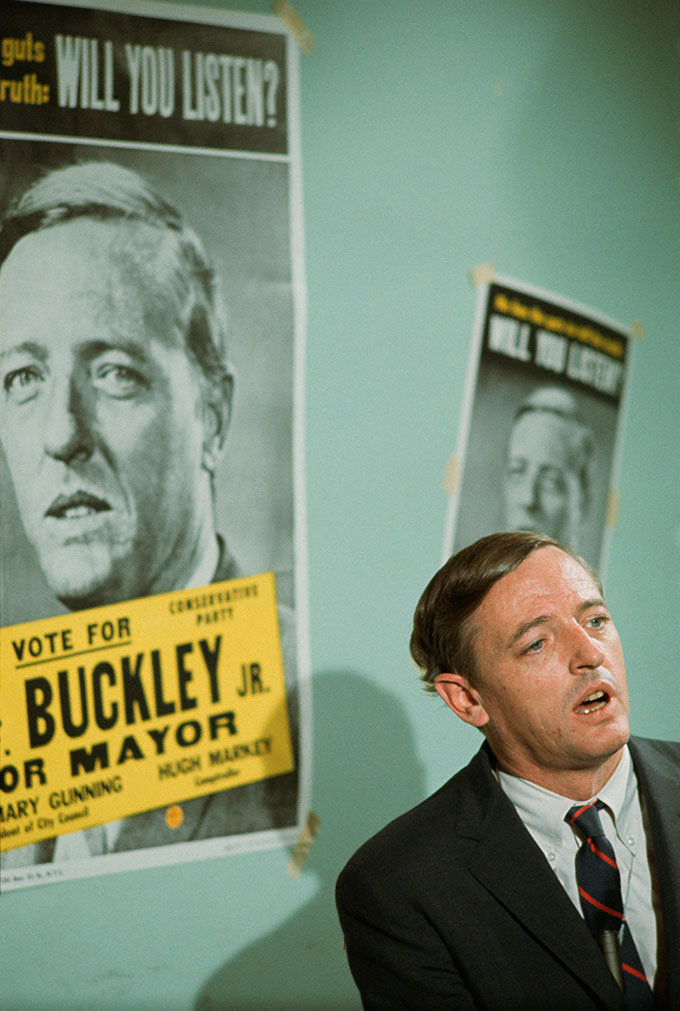The biography that Sam Tanenhaus began in 1998, Buckley: The Life and the Revolution That Changed America, has finally been published. Part of the reason Tanenhaus spent one year writing for every three that William F. Buckley Jr. (1925–2008) spent living is that Buckley’s cruising speed, to borrow one of his memoirs’ titles, was overdrive, to borrow another. He wrote more than 50 books, some 5,600 syndicated columns, and hundreds of editorials for National Review, the magazine he founded and edited. It seems entirely possible that Tanenhaus read them all.
In addition, Buckley gave an average of 70 public speeches a year over four decades and taped more than 1,500 episodes of his television show Firing Line. As an avid sailor, skier, traveler, amateur musician, and socialite, he worked harder at relaxing than most people do at working. He “lived in a kind of blur,” Tanenhaus writes in Buckley, which—at great length (1,040 pages) but with only partial success—attempts to bring its subject into focus.
Finally, a reason to check your email.
Sign up for our free newsletter today.
The book’s 27-year gestation may have been unavoidable. One obvious complication: Tanenhaus served as editor of the New York Times Book Review from 2004 to 2013. But the delay remains regrettable. The year 1998—when Buckley turned 73—was a long time ago. Much has changed, including the book’s rationale. (Undertaken with Buckley’s enthusiastic cooperation, it is widely described as his official biography.) By then, in the final stage of a long and very public career—he had written two bestsellers and founded National Review before turning 30—Buckley remained famous but had grown less influential. His columns and Firing Line appearances were quoted, attacked, or even noticed with decreasing frequency. Had Buckley appeared during the decade that its subject had left to live, it might have told readers familiar with the name who the celebrity intellectual really was, what he did, and how he had shaped events.
Published 17 years after Buckley’s death, Tanenhaus’s biography bears a different burden: to convey its subject’s significance to readers whose memories of Buckley have faded—or who are too young to remember him at all. Most biographies provide an introduction, which offers the frame that will be used throughout the book, acquainting or reacquainting the reader with the subject, his times, and his impact. Buckley suffers from skipping such an introduction. Instead, it accurately describes Buckley as “the intellectual leader of the modern conservative movement” in the book’s opening line, then quickly shifts to a detailed account of his childhood. The biography never fully recovers from this initial mistake. Over the course of a very long book, readers come away with a much clearer sense of what made Buckley interesting (and he was, exceedingly so) than of what made him important.
That purpose would have been served by stating, at the outset, that American conservatism was inchoate in 1950, when: a) William Buckley graduated from Yale University and b) literary critic Lionel Trilling published his collection of essays The Liberal Imagination. “In the United States at this time,” Trilling wrote in its preface, “liberalism is not only the dominant but even the sole intellectual tradition.” The “conservative impulse” was present but, apart from rare exceptions, did not express itself in ideas “but only in action or in irritable mental gestures which seek to resemble ideas.”
Trilling’s critique, though not entirely fair, was far from groundless. Whether in response to Trilling or, more plausibly, to address the situation that Trilling described, Buckley sought to make conservatism politically potent by making it intellectually formidable. He was not, as Tanenhaus makes fully—and even excessively—clear, a political theorist. Instead, Buckley synthesized and publicized conservative ideas in ways unprecedented and still unequaled. Buckley was a prodigious writer who, despite his vast, intimidating vocabulary, had a gift for conveying big ideas with a single brushstroke: “I should sooner live in a society governed by the first 2,000 names in the Boston telephone directory than in a society governed by the 2,000 faculty members of Harvard University” or “Though liberals do a great deal of talking about hearing other points of view, it sometimes shocks them to learn there are other points of view.”
But the exertions that made Buckley conservatism’s indispensable man went far beyond witty epigrams. A deft, exacting editor, he was a shrewd judge of literary talent. By discovering, encouraging, and promoting such writers as Richard Brookhiser, Charles R. Kesler, George F. Will, and Rich Lowry, National Review’s present editor in chief, Buckley gave the conservative movement intellectual bench strength, something it had not previously known. If liberals refused to admit that there were other points of view, Buckley’s conservative movement would circumvent them, making arguments that appealed to broader audiences, the names in the phone book. For this to work, Buckley was required to make prudential judgments about which provocations would move what we now call the Overton Window—the range of acceptable opinion—and which, by virtue of giving offense without giving pause, would damage the conservative movement. Though not clairvoyant, and therefore not always correct in these matters, Buckley was right far more often than he was wrong, guiding the explication of conservatism in a direction that made possible political victories long considered unimaginable.
That Buckley became famous in the process was not just agreeable to him but invaluable to conservatism. A 1967 Time cover of Buckley carried the headline “Conservatism Can Be Fun.” More important, Buckley the celebrity made clear that conservatism could be cool, rather than a political persuasion burdened by scolding spokesmen. In a vignette that would have enhanced Buckley but instead wound up in a recent interview in The Atlantic, Tanenhaus spoke of listening to the audiotape of a speech that Buckley made in 1965: “I have never heard anyone command an audience the way he does on that tape—the jokes, the erudite wit, the phrasing and polish, the mellifluous voice, the charm.” Tanenhaus went on to spell out the political impact of such rhetorical virtuosity: “Liberals found themselves thinking, I don’t agree with him but he’s smarter than I am, and maybe I should hear him out. Getting people to listen, to drop their defenses and let you inside their minds, is the all-important first step in winning the argument.”
Certainly, publishing insiders know what Buckley’s readers cannot: how many of the book’s shortcomings stem from its editors and publisher rather than the author. Buckley often feels both slight and hurried—unexpected flaws in a thousand-page book that took a quarter-century to write. In a 2021 interview, Tanenhaus said that he had anticipated submitting a manuscript that would result in a 2,000-page volume.
In fact, it’s easy to imagine this project succeeding as a two-volume biography. Volume 1 would take Buckley through 1964, when his efforts to will, argue, and write the conservative movement into existence culminated in Barry Goldwater’s nomination—and the Right’s ascendancy within the Republican Party. Volume 2 would begin in 1965, when Buckley’s mayoral campaign in New York not only made him a household name but also helped catalyze conservatism’s remarkable recovery from Goldwater’s defeat. By the twentieth anniversary of that loss, Ronald Reagan—a National Review conservative—had won two presidential elections decisively.
What we get instead is a “definitive” one-volume biography that leaves Buckley hazily defined. The greatest disappointment is the concluding section—the book’s shortest—which rushes through the final 34 years of Buckley’s life, beginning in 1974, when he was 48. Buckley devotes less than one-eighth of its text to the latter three-fifths of its subject’s adult life, the period in which Reagan’s victories made Buckleyite conservatism not just the GOP’s philosophy, but the nation’s. That these decades are treated cursorily rather than carefully is baffling.
More broadly, Tanenhaus and Penguin Random House have delivered a peculiar literary product. Rather than frame a coherent perspective on this large American life, Buckley offers rich ingredients of a narrative but invites readers to construct their own story from it. Readers disposed to dislike both Buckley and conservatism are given plenty to work with—as reflected in enthusiastic reviews from The New Yorker, The New Republic, and the New York Times. Those more favorably disposed to the man and the movement receive some, but decidedly less, material, a fact reflected in the Wall Street Journal’s critical review.
But no conservative could have expected a hagiography from an author who paused his work at the New York Times to write The Death of Conservatism (2009). In any case, good laudatory biographies already exist—by Lee Edwards (2010) and Alvin Felzenberg (2017). Buckley is not, however—to the relief of many conservatives—a hatchet job. Tanenhaus writes admiringly at times, making clear, for instance, that Buckley sincerely and thoroughly repudiated the opposition to civil rights that he had voiced throughout National Review’s first decade. Tanenhaus closes the book by urging readers to “discover in ourselves the imagination and generosity, the kindness and warmth, that Bill Buckley demonstrated time and again in his long and singular life.”
The uncertainty over how conservatives should respond to Buckley is evident at National Review, the magazine he founded. The review in its book section, written by Buckley protégé and friend Richard Brookhiser, generously praises Tanenhaus for his “acute” judgments on Buckley’s writing, the “perspective” gained from years of labor, and the honor the book confers on its subject. An editorial on the NR website is far chillier, calling the biography “flawed,” “blighted by Tanenhaus’s hobbyhorses,” and failing to “do justice to a man who lived a legendary life and changed the 20th century.”
Perhaps National Review could have worked harder to reach an internal consensus on Buckley, but much of the ambivalence that the biography elicits is well earned. Despite his book’s heft, Tanenhaus’s view of Buckley remains elusive. His affection and admiration for a man whose life was “massively lived and matchlessly productive” are clear. His opinion of conservatism, however, is more hesitant—a serious complication, given that the only real justification for reading, let alone writing and publishing, a long biography of Buckley is his central role in the rise of American conservatism.
As he makes explicit in The Death of Conservatism and frequently implies in Buckley, Tanenhaus draws a sharp line between good conservatism and bad conservatism. The essential distinction is acquiescence. Good conservatives, recognizing that progressives are indeed on the right side of history, are committed to “replenishing civil society by adjusting to changing conditions,” as he put it in the earlier book. These changes invariably move toward more generous welfare policies, stricter regulation of private enterprise, and greater acceptance—even promotion—of unconventional lifestyles, what John Stuart Mill called “experiments in living.” Bad conservatives, by contrast, are “revanchists committed to a counterrevolution” that seeks to restore the pre–New Deal order, revive “Cold War–style Manichaeanism,” or resurrect straitlaced “family values.”
Good conservatism, in Tanenhaus’s account, proves its worth when liberalism, driven by its internal logic and passions, overreaches or fails to resist external radicalism. This, he argues, was the case in the 1960s, when the confident, pragmatic liberalism of the New Frontier was swept away—partly by the social engineering hubris of the Great Society and partly because liberals could not bring themselves to oppose or even criticize the New Left and Black Power movements, however violent their words and deeds. In this context, conservatism’s commitment to stability upheld the social order, unintentionally giving liberalism the space to recover its poise and sobriety.
Prominent among The Death of Conservatism’s critics was Jonah Goldberg, still with National Review in 2009, who derided Tanenhaus’s “Sherpa” conservatives. These docile, subservient figures, he wrote, “know their place”—happily assisting “the great mountaineers of liberalism, pointing out occasional missteps, perhaps suggesting a slight course correction from time to time, but never losing sight of the need for upward ‘progress.’ ”
I would add that Tanenhaus fails to consider the possibility that conservatives had good reason to oppose liberalism not just episodically, in response to intolerable provocation, but continuously and comprehensively. A liberalism chronically susceptible to excess and radicalism—whether from the New Left then or woke social-justice warriors now—has forfeited the benefit of the doubt. It warrants not a loyal opposition that objects only to its most egregious overreaches, but a principled one that rejects it root and branch. Yes, a community beset by arson must fortify its fire department. But what it ultimately needs is a better arson squad: one that apprehends those who burn down buildings for fun or profit and deters others inclined to try.
The least absurd way to reduce Buckley’s thousand pages to a single sentence might be: William F. Buckley began as a bad conservative but, after the 1960s, became a good one—or at least a much better one. As a bad conservative in 1956, Buckley argued that President Dwight Eisenhower—who had rolled back neither the New Deal nor global Communism—was only marginally preferable to Adlai Stevenson, the liberal hero of the day. As a good conservative in 1974, Buckley broke with most on the right to support President Gerald Ford’s choice of Nelson Rockefeller—liberal Republicanism personified—as vice president. Watergate, Buckley maintained, had rendered this decision a prudential imperative for the GOP: “A political party that came that close to dissolution needs to gather up its icons, and principal among these is, to be sure, Nelson Aldrich Rockefeller.”
My one-sentence summary does Tanenhaus an injustice by oversimplifying his often captivating and elegant biography, the result of prodigious research. But it also gives him an unearned compliment by overclarifying his work. The politics of Buckley the book are far murkier than those of Buckley the man. A biography whose subtitle promises to explicate “the life and the revolution that changed America” ought to offer a reasonably clear perspective on what that revolution stood for, what those changes amounted to, and whether they were, on balance, beneficial or harmful. Readers might find fault with the vantage point from which such judgments are rendered, but they would at least finish the book with a clear sense of what that vantage point is.
Instead, in Buckley’s penultimate paragraph—where we might expect a distillation of the meaning and significance of the remarkable story just told—we get only a shrug: “In [Buckley’s] time, as in our own, no one really could say what American conservatism was or ought to be.” Tanenhaus concludes by calling Buckley “the country’s greatest conservative”—a warm but weightless accolade in a book whose takeaway is that the practical impact and moral worth of his preeminence remain beyond assessment.
Buckley, National Review’s editors charge, is marred by “strange lacunae throughout.” None is stranger than the fact that Donald Trump’s name is mentioned exactly once, in the context of a 1986 effort to disbar attorney Roy Cohn, which Trump, Buckley, and dozens of other prominent New Yorkers opposed. There is, elsewhere in the book, a glancing reference to the “earthquake election of 2016.”
It’s true that Buckley died in 2008. But American history did not end there, nor did conservatism stop “adjusting to changing conditions,” as Tanenhaus urged it to do in 2009. Buckley fails to explore what Buckleyism and Trumpism might reveal about each other—and proceeds as if the question has never occurred to the author or his readers.

This approach might have worked had Trump lost the 2024 election, which took place as Tanenhaus and his publisher were putting the final touches on the book. In that case, one could argue that 2016 was indeed an earthquake—but also an anomaly, a moment whose sound and fury signified nothing of lasting import. The assumption that Buckley would be remembered long after Trump was forgotten might, under those circumstances, justify telling Buckley’s story without reference to the 45th president. But that premise collapsed the moment Trump crossed the electoral threshold to become the 47th president. After 2024, the relationship between Buckleyism and Trumpism is not only hotly debated; it is also central to understanding the nature and direction of the conservative movement, Buckley’s legacy.
My guess is that Penguin Random House judged it less risky to publish a biography that ignored this crucial question than to delay Buckley yet again, missing its subject’s centenary and risking further postponement—perhaps until 2055, the centenary of both National Review and Sam Tanenhaus. Evidence supporting—though not confirming—this hypothesis appears in interviews and articles released as part of the book’s publicity campaign, in which Tanenhaus devotes considerable attention to the Buckley–Trump connection. The weekend before the book’s publication, for example, the New York Times ran his essay, “The Cerebral, Bach-Loving Patrician Who Wrote Trump’s Playbook.” We are told that it’s adapted from Buckley, but it reads more like a compilation of paragraphs left on the cutting-room floor, sacrificed so that a book already very late and very long would not become even later and longer.
It’s a shame that this material—thoughtful and provocative, on par with the best parts of Buckley—never made it into the book. Perhaps part of the reason is that Tanenhaus is still grappling with the question and was unwilling to commit in print to an opinion not yet settled in his own mind. In the Atlantic interview, he asks whether those of Buckley’s “admirers and acolytes” who have become Trumpists are betraying or fulfilling his legacy. “There are arguments to be made on both sides,” Tanenhaus says, before declining to pick either.
The position that Tanenhaus takes in his Times essay—that Trump is, in many ways, continuing what Buckley began—seems less conflicted but comes with striking caveats. Many on the left argue that the ugliness of Trump’s politics is the culmination of Buckley’s project, making Trump a convenient weapon for attacking both Buckley and conservatism. Louis Menand’s New Yorker review of Buckley, for instance, concludes that Buckley was a “zealot” whose politics aligned more with Trump than with Reagan—and who might have accepted Trump’s modus operandi as readily as he once defended Joe McCarthy’s in the 1950s.
Up to a point, Tanenhaus agrees, calling Trump Buckley’s “heir” in “important respects.” But unlike most left-of-center writers who link Buckley to Trump to score points, Tanenhaus updates a case he made in The Death of Conservatism: liberals bear much of the blame for liberalism’s vulnerability to conservative attack. Buckley’s “theme of duplicity and presumption in high places,” Tanenhaus writes in the Times, “remains a staple of conservative thinking in the Trump years—whether it is the covered-up facts of the forever wars in Afghanistan and Iraq, the long-ignored costs of neoliberal economic policies that hollowed out industrial areas or the unacknowledged costs of an intolerant woke culture that privileges some groups while reducing others to silence.”
The relationship between Buckley and Trump is also contested among conservatives. For critics like Brookhiser and Will, Trump’s coarse manner is inseparable from the coarseness of his politics. Conservatism, they argue, must be reclaimed by men of character and intellect, like Buckley and Reagan. In his review of Buckley, Brookhiser calls Trump a “malignant clown,” whose prominence within conservatism is “our problem,” not Buckley’s fault.
There appears to be no clear solution to this problem, as restoring conservatism to its status quo ante-Trump grows increasingly implausible. And the awkward fact is that Trump, over one full term and the beginnings of another, has delivered on goals that conservatives had spent generations trying to achieve.
Consider affirmative action. Since Lyndon Johnson’s 1965 executive order made it integral to federal operations, six Republican presidents—Trump (as 45) among them—held the Oval Office for a combined 32 years without rescinding it, despite a steady drumbeat of conservative criticism. In 2025, Trump (as 47) finally signed an executive order nullifying Johnson’s. His action built on the Supreme Court’s 2022 decision declaring affirmative action unconstitutional in college admissions—a decision made possible by the three justices Trump appointed in his first term.
Those same three were part of the six-justice majority that year to overturn Roe v. Wade, which conservatives had denounced for nearly half a century with little effect. And while the game is not over, Trump 47 has already done more to defund public broadcasting and the Department of Education than any of his Republican predecessors—not to mention the conservative commentators who spent decades demanding just that.
The growing number of conservatives who are pro-Trump, or at least Trump-tolerant, think that Tanenhaus got it exactly wrong in The Death of Conservatism. The good conservatives are the troublemakers: those who do not accept that it is indecent to disparage and impossible to reverse liberalism’s advances. The bad conservatives are the acquiescent ones, Goldberg’s Sherpas or Michael Anton’s Washington Generals, whose role in our politics is “to show up and lose.”
In 1955, William F. Buckley launched National Review—and the conservative movement—with the famous declaration that the magazine “stands athwart history, yelling Stop.” Within conservatism, there has long been debate over whether the yelling is the point, decrying the demise of civic and social virtues too good to endure in this benighted world, or whether the real goal is to effect some stopping. Due to changes that Donald Trump both causes and reflects, the stoppers are now ascendant over the yellers. While Sam Tanenhaus disapproves of this shift, his imperfect but valuable biography does little to dispel the suspicion that William Buckley would have welcomed it.
Top Photo: In 1955, William F. Buckley launched National Review—and the conservative movement—with a declaration that the magazine “stands athwart history, yelling Stop.” (Nick Machalaba/Fairchild Archive/Penske Media/Getty Images)
Source link

















